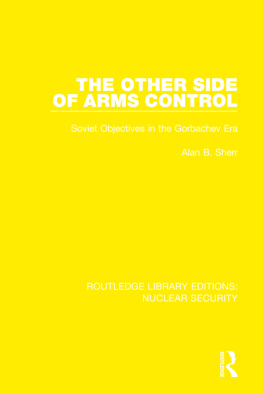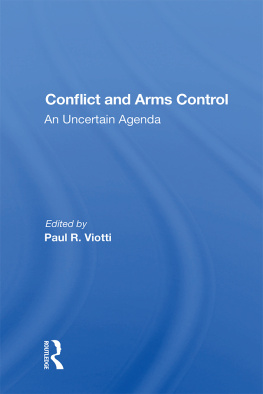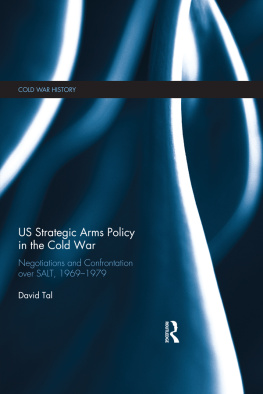ROUTLEDGE LIBRARY EDITIONS: NUCLEAR SECURITY
Volume 6
AGREEMENTS FOR ARMS CONTROL
First published in 1982 by Taylor & Francis Ltd
This edition first published in 2021
by Routledge
2 Park Square, Milton Park, Abingdon, Oxon OX14 4RN
and by Routledge
52 Vanderbilt Avenue, New York, NY 10017
Routledge is an imprint of the Taylor & Francis Group, an informa business
1982 by Stockholm International Peace Research Institute
All rights reserved. No part of this book may be reprinted or reproduced or utilised in any form or by any electronic, mechanical, or other means, now known or hereafter invented, including photocopying and recording, or in any information storage or retrieval system, without permission in writing from the publishers.
Trademark notice: Product or corporate names may be trademarks or registered trademarks, and are used only for identification and explanation without intent to infringe.
British Library Cataloguing in Publication Data
A catalogue record for this book is available from the British Library
ISBN: 978-0-367-50682-7 (Set)
ISBN: 978-1-00-309763-1 (Set) (ebk)
ISBN: 978-0-367-51351-1 (Volume 6) (hbk)
ISBN: 978-1-00-305349-1 (Volume 6) (ebk)
Publishers Note
The publisher has gone to great lengths to ensure the quality of this reprint but points out that some imperfections in the original copies may be apparent.
Disclaimer
The publisher has made every effort to trace copyright holders and would welcome correspondence from those they have been unable to trace.
Agreements for Arms Control: A critical survey
sipri
Stockholm International Peace Research Institute
Sipri is an independent institute for research into problems of peace and conflict, especially those of arms control and disarmament. It was established in 1966 to commemorate Swedens 150 years of unbroken peace.
The Institute is financed by the Swedish Parliament. The Staff, the Governing Board and the Scientific Council are international.
Governing Board
Dr Rolf Bjrnerstedt, Chairman (Sweden)
Dr Egon Bahr (FR Germany)
Mr Tim Greve (Norway)
Dr Max Jakobson (Finland)
Professor Karlheinz Lohs (German Democratic Republic)
Professor Leo Mates (Yugoslavia)
The Director
Director
Mr Frank Blackaby (United Kingdom)
sipri
Stockholm International Peace Research Institute
Bergshamra, S-171 73 Solna, Sweden
Cable: Peaceresearch, Stockholm
Telephone: 08-55 97 00
Agreements for Arms Control:
A critical survey
Jozef Goldblat
sipri
Stockholm International Peace Research Institute
First published 1982 by Taylor & Francis Ltd
4 John St, London WC1N 2ET
Copyright 1982 by SIPRI
Bergshamra, S-171 73 Solna, Sweden
All rights reserved. No part of this publication may be reproduced, stored in a retrieval system or transmitted, in any form or by any means, electronic, mechanical, photocopying, recording or otherwise, without the prior permission of the copyright owner.
Distributed in the United States of America by
Oelgeschlager, Gunn & Hain, Inc.
1278 Massachusetts Avenue, Harvard Square,
Cambridge, MA 02138
and in Scandinavia by
Almqvist & Wiksell International,
26 Gamla Brogatan,
S-101 20 Stockholm, Sweden
British Library Cataloguing in Publication Data
Goldblat, Jozef
Agreements for arms control.
1. Arms control
I. Title II. Stockholm International Peace Research Institute
327.174JX1974
ISBN 0 85066 229 X
Typeset by Georgia, Liverpool L3 9EG
Printed and bound in the United Kingdom by
Taylor and Francis (Printers) Ltd, Rankine Road,
Basingstoke, Hampshire RG24 0PR
Preface
The United Nations declaration proclaiming the 1980s as the Second Disarmament Decade stressed the need to mobilize world public opinion on behalf of peace and disarmament. SIPRI contributes to such a mobilization by spreading objective information about the arms race and about the efforts made to stop it. This book serves the latter purpose. It is a comprehensive handbook on arms control, containing a critical analysis and assessment of the arms control agreements and of current negotiations, free of the usual bias of official government reports.
The book is published on the occasion of the 1982 UN General Assembly Special Session devoted to disarmament but it has not been prepared only for diplomats or other officials participating in this session. The intention is to facilitate the work of all those dealing with arms control and disarmament problems, including scholars, politicians and other concerned citizens.
Acknowledgements: Acknowledgement is given to Ragnhild Ferm for compiling the documentary and statistical material in the book, and to Connie Wall for editing the manuscript.
April 1982
Jozef Goldblat
Measures for the limitation of armaments can take various forms. They can be taken by states on a voluntary basis, without reciprocity. They can be part of agreed armistice arrangements following armed conflicts. They can also be imposed upon defeated countries, as in the case of Germany after both World Wars. This book, however, is concerned only with agreements freely arrived at in time of peace among sovereign states, through a process of formal intergovernmental negotiation, and providing for mutual rights and obligations.
A multitude of proposals for regulation of armaments, including proposals for the complete elimination of armed forces and weapons, have been made in various forums, but so far only so-called arms control measures have been agreed upon, imposing certain restrictions on the armament policies of states. Originally, the term arms control, coined in the USA, was meant to denote internationally agreed rules limiting the arms competition rather than reversing it; it had a connotation distinct from the reduction of armaments or disarmament. Subsequently, however, diverse measures intended to freeze, limit or abolish specific categories of weapons; to prevent certain military activities; to regulate the deployment of forces; to proscribe transfers of militarily important items; to reduce the risk of an accidental war; to constrain or prohibit the use of certain arms in war; or to build up confidence among states through greater openness in the military field, and thereby produce an international climate conducive to disarmament, have come to be included under the rubric of arms control. It is in this broad sense that the term arms control will be used here, often interchangeably with arms limitation or disarmament.
This publication deals primarily with the bilateral and multilateral arms control agreements reached since World War II. In the latter category of agreements, several are of a regional nature in the sense that they are valid only for a given geographical zone or continent. The forms of the agreements discussed in this book vary from treaties, conventions or protocols, to memoranda, declarations or common understandings, to statutes, charters and special binding decisions of international bodies or final acts of international conferences, to joint or simultaneous statements by governments, to exchanges of letters among the states concerned.











